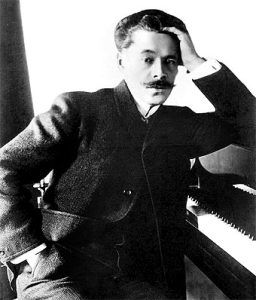
By Robert Croan
Once again, the South Florida Symphony has brightened up an otherwise arid musical summer with its superb and valuable chamber music series. The second of three seasonal concerts this year [heard 6/21 at Fort Lauderdale’s Center for Spiritual Development] was devoted to piano trios by Russian composers. The composers were Mikhail Glinka, Sergei Rachmaninov and Anton Arensky, and the players (first-deskers from the orchestra) were violinist Huifang Chen, cellist Christopher Glansdorp and pianist Catherine Lan.
Each of the works offered has a significant elegiac segment, yet without an overall funeral mood. This is especially true of Glinka’s Trio Pathétique (in D minor), the earliest piece on the program (1832), which, except for its third-movement Largo, is rippling and effervescent. Although Glinka is thought of today as the father of the Russian classical style, there’s nothing specifically Russian in this work.
Without the folk themes that Glinka would later weave into his music, this trio suggests the manner of Glinka’s German contemporary Felix Mendelssohn, along with infectious melodies in the mold of the Italian bel canto opera composers of his time — notably, Gaetano Donizetti and Vincenzo Bellini. The music is light and delightful for almost all of its 15-minute duration. Originally written for the unusual combination of clarinet, bassoon and piano, it was quickly taken over in an alternation instrumentation for the standard piano trio with strings.
The opening Allegro is a standard sonata form movement, which the players rendered with strength and a sense of the fun of alternating dialogues between the violin and cello. The second movement scherzo and fourth movement finale are astonishingly brief, but the “pathetique” element of the Largo gave all three performers a chance to emote, if only just a little.
There could hardly be a greater contrast between Glinka’s sprightly confection and Rachmaninov’s Trio élégiaque No. 1 (in G minor), a student-period opus which opened the program, allowing the players to warm up on some serious stuff. Or, to be more specific, mostly the pianist, whose part (rendered with digital muscularity by Lan) dominates the others with big clustered chords and heart-on-the-sleeve storm and furor.
It’s an odd, unsatisfying work, also about 15 minutes long, beginning with a “lugubrious Lento,” then wandering the gamut in its themes and harmonies into a two-minute funeral march that seems to appear out of nowhere and simply disappear. That coda was, in this performance, the expressive highlight.
The meat of the concert was Arensky’s gripping and appealing Piano Trio No. 1 (in D minor, Op.32), composed only two years later than the Rachmaninov First Trio, but Arensky’s is a mature accomplishment in the tradition of the composer’s predecessors, Peter Ilyich Tchaikovsky and Nikolai Rimsky-Korsakov — the latter having been Arensky’s teacher. (Arensky, in turn, was the teacher of the younger Rachmaninov.)
The trio begins with a lyrical Allegro, its main theme stated first by the violin — quite exquisite under Chen’s sweet-toned fingers — in turn picked up by the cello and keyboard. Arensky dedicated this work to the memory of a revered, recently deceased older Russian cellist, Karl Davydov, and that instrument has intermittent solo turns, in which Glansdorp took full advantage of his opportunities to shine. The Scherzo movement is a whirlwind flight of fancy, its volatile principal theme set off by a sweet-tuned waltz.
It’s especially to the credit of these artists that they were able to switch so seamlessly from one mood to another, conveying a wide range of feeling through subtleties of tonal color and nuance. The third movement “Elegy” delivered serenity rather than sadness — again, much of it intrinsic to the cello’s opulent sonorities while the vigorous finale brought us back to earth with turbulent rhythms and an ultimate feeling of elation.
The third and final concert in the South Florida Symphony’s chamber series will offer string quartets by Mendelssohn and Ravel, July 25 at Temple Israel of Greater Miami; and July 26 at Fort Lauderdale’s Center for Spiritual Development.